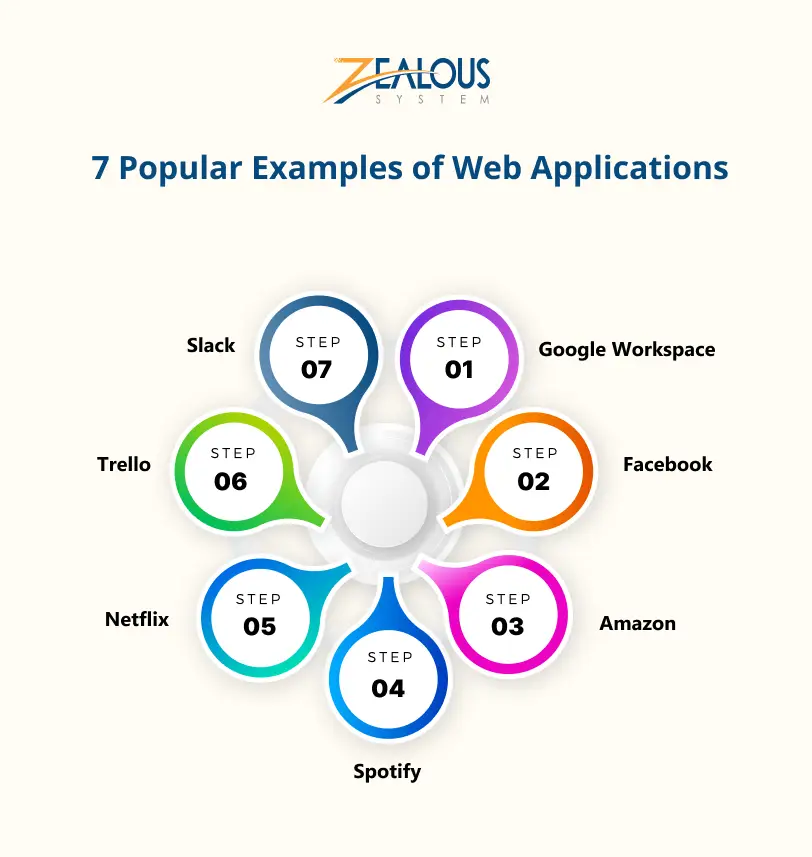
We use cookies and similar technologies that are necessary to operate the website. Additional cookies are used to perform analysis of website usage. please read our Privacy Policy
Web Application Examples: Building Scalable and Reliable Solutions

Web applications have become an integral part of our daily lives, seamlessly blending into various aspects of our personal and professional routines. From social networking platforms to online banking, these web application examples facilitate a wide range of activities, making our tasks more efficient and accessible.
Web applications, or web apps, are software programs that run on web servers and can be accessed through web browsers. Unlike traditional software, which requires installation on a local device, web applications offer the convenience of being accessible from anywhere with an internet connection. This accessibility, coupled with the ability to perform complex functions, makes web applications a critical component of modern digital infrastructure.
In this blog, we will explore various types of web applications, from simple static web apps to advanced progressive web apps, and provide popular web application examples that illustrate their practical applications.
By examining these examples, we can gain a better understanding of how web applications have transformed the way we interact with technology and the internet.
What Is a Web Application?
A web application, or web app, is a software application that runs on a web server rather than being installed on the local operating system of a device. Web applications can be accessed through a web browser with an internet connection, eliminating the need for downloading and installing software. This characteristic makes them highly versatile and user-friendly, as they can be used across different devices and operating systems.
How Do Web Applications Work?
Web applications function through a combination of client-side and server-side scripts. Here’s a simplified overview of the process:
- Client-Side Code: This is written in languages like HTML, CSS, and JavaScript, which are interpreted by the web browser. The client-side code is responsible for the visual presentation and user interaction aspects of the web app.
- Server-Side Code: This is written in languages like Python, Java, Ruby, PHP, and others. The server-side code handles the business logic, database interactions, and server operations.
- HTTP Requests and Responses: When a user interacts with a web application, their actions trigger HTTP requests sent from the client-side code to the server. The server processes these requests, performs the necessary operations, and sends back an HTTP response along with any required data.
- Database: Web applications often interact with databases to store and retrieve information. Databases like MySQL, PostgreSQL, MongoDB, and others are commonly used to manage data.
- Rendering: The server’s response is rendered on the client-side, updating the web application interface dynamically.
Types of Web Apps

Web applications can be categorized into several types based on their functionality, complexity, and the technology used. Here are the most common types:
1. Static Web Applications:
These applications deliver pre-rendered content to the user’s browser without any interaction with the server once the page is loaded. Examples include portfolio websites and informational pages.
2. Dynamic Web Applications:
These apps fetch data in real-time and update the web page accordingly. They rely on server-side processing and databases. Examples include social media platforms and online marketplaces.
3. Single-Page Applications (SPAs):
SPAs load a single HTML page and dynamically update the content as the user interacts with the app. This creates a smoother and faster user experience. Popular frameworks for SPAs include Angular, React, and Vue.js.
4. Multi-Page Applications (MPAs):
These applications consist of multiple pages that reload each time the user navigates to a new page. They are commonly used in large applications with various features and sections, such as e-commerce websites.
5. Progressive Web Applications (PWAs):
PWAs combine the best of web and mobile applications. They are built using web technologies but offer an app-like experience, including offline capabilities and push notifications. Examples include Twitter Lite and Pinterest.
7 Popular Examples of Web Applications

Web applications have revolutionized the way we work, communicate, shop, and entertain ourselves. Here are some of the most popular and impactful web applications, along with their key features:
1. Google Workspace
Google Workspace, formerly known as G Suite, is a collection of cloud-based productivity and collaboration tools developed by Google. It includes applications like Google Docs, Sheets, Slides, Drive, and Gmail, which are widely used in both personal and professional settings.
Key Features:
- Real-Time Collaboration: Multiple users can work on the same document simultaneously, with changes being reflected in real-time.
- Cloud Storage: Google Drive provides ample storage space for files and documents, accessible from any device with an internet connection.
- Integration: Seamless integration with other Google services and third-party applications.
- Accessibility: Cross-platform availability ensures that users can access their files from any device, anywhere.
- Security: Advanced security features, including two-factor authentication and encryption.
2. Facebook
Facebook is one of the largest social media platforms globally, allowing users to connect with friends and family, share content, and interact with various communities. It serves as a hub for social networking, news, and entertainment.
Key Features:
- News Feed: Personalized content feed showing updates from friends, pages, and groups.
- Messaging: Integrated messaging service through Facebook Messenger for real-time communication.
- Groups and Pages: Users can join groups or follow pages to engage with communities of interest.
- Events: Creation and management of events, allowing users to RSVP and invite others.
- Marketplace: A platform for buying and selling items locally.
3. Amazon
Amazon is the world’s largest online retailer, offering a vast array of products ranging from books and electronics to clothing and groceries. The web application provides a comprehensive shopping experience, including customer reviews and personalized recommendations.
Key Features
- Product Search and Filters: Advanced search options and filters to help users find products quickly.
- Customer Reviews and Ratings: Detailed reviews and ratings from other customers to aid in purchasing decisions.
- Personalized Recommendations: Suggestions based on browsing and purchase history.
- Order Tracking: Real-time tracking of orders and delivery updates.
- Prime Membership: Exclusive benefits for Prime members, including free shipping and access to streaming services.
4. Spotify
Spotify is a leading music streaming web application that offers access to millions of songs, podcasts, and playlists. Users can stream music for free with ads or subscribe to a premium service for an ad-free experience.
Key Features:
- Extensive Library: Access to a vast collection of songs and podcasts.
- Personalized Playlists: Custom playlists such as Discover Weekly and Release Radar tailored to user preferences.
- Social Sharing: Integration with social media platforms for sharing music and playlists with friends.
- Offline Listening: Ability to download songs for offline playback with a premium subscription.
- Cross-Platform Support: Available on web, mobile, desktop, and smart devices.
5. Netflix
Netflix is a subscription-based streaming service that offers a wide variety of TV shows, movies, documentaries, and original content. It provides a user-friendly interface and personalized viewing experience.
Key Features
- Extensive Content Library: A large selection of movies, TV shows, and original content.
- Personalized Recommendations: Suggestions based on viewing history and preferences.
- Multiple Profiles: Ability to create multiple user profiles under one account, each with personalized recommendations.
- Offline Viewing: Option to download content for offline watching.
- High-Quality Streaming: Support for HD, 4K, and HDR streaming.
6. Trello
Trello is a project management web application that helps teams organize tasks and collaborate efficiently. It uses boards, lists, and cards to represent projects and their progress visually.
Key Features
- Visual Task Management: Boards, lists, and cards provide a clear and intuitive way to manage tasks.
- Collaboration Tools: Features like comments, attachments, and mentions facilitate team collaboration.
- Integrations: Supports integration with various other tools such as Slack, Google Drive, and Jira.
- Automation: Built-in automation (Butler) for repetitive tasks to streamline workflows.
- Customizable Workflows: Users can customize boards and cards to fit their project needs.
7. Slack
Slack is a communication and collaboration platform designed for teams. It offers real-time messaging, file sharing, and application integration with other tools, making it essential for modern workplaces.
Key Features
- Channels: Organized communication channels for different teams, projects, or topics.
- Direct Messaging: Private messages for one-on-one or small group conversations.
- File Sharing: Easy sharing of files and documents within conversations.
- Integrations: Connects with numerous third-party apps and services like Google Drive, Trello, and GitHub.
- Searchable History: Full-text search of the entire message history for quick information retrieval.
Conclusion
Web applications have significantly enhanced our ability to perform a wide range of activities online, from communication and collaboration to entertainment and shopping. The examples discussed above—Google Workspace, Facebook, Amazon, Spotify, Netflix, Trello, and Slack—demonstrate the diversity and flexibility of web applications in today’s digital environment. As technology continues to evolve, web application development companies will play a crucial role in creating even more innovative and user-friendly web applications, further transforming how we interact with the internet.
We are here
Our team is always eager to know what you are looking for. Drop them a Hi!
Umang Baraiya
I am currently working as a business analyst at Zealous System. I am experienced in working with stakeholders and managing project requirements, Documentation of requirements, and planning of product backlog.
Table of Contents
×


Comments